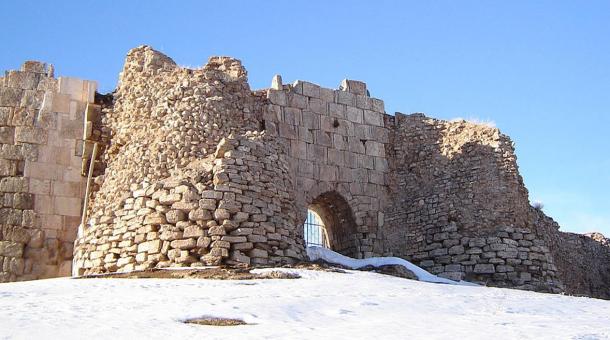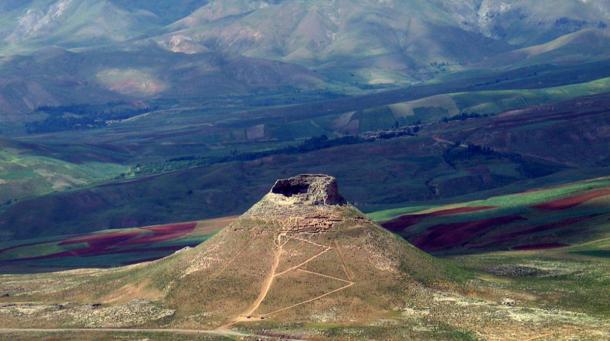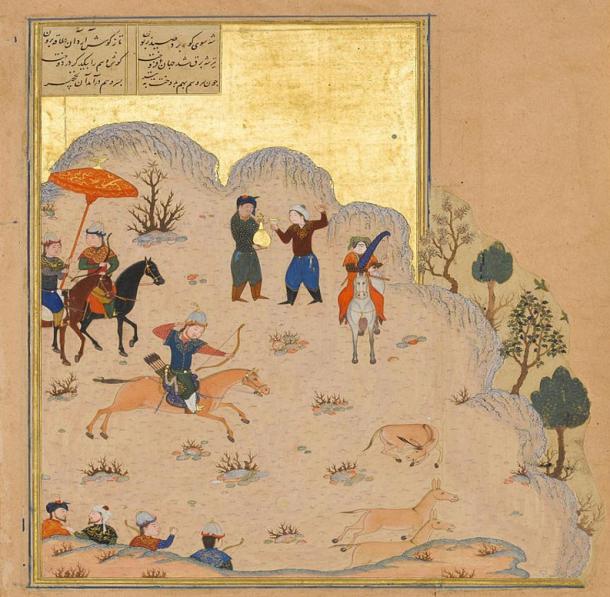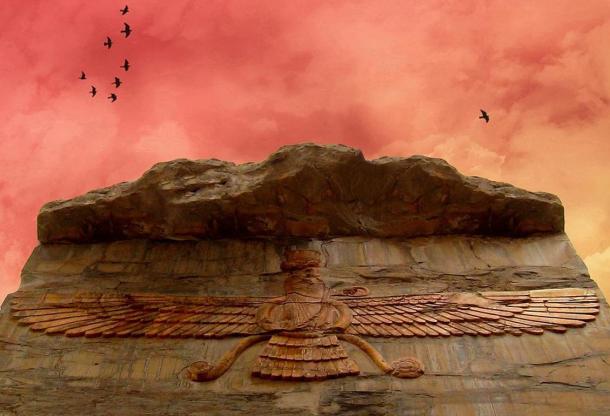
The Ancient Site of Takht-e Soleyman: Iran’s Throne of King Solomon
Between the 3 rd and 7 th centuries AD, the country now named Iran was part of the Sasanian Empire, Rome’s great rival in the East. Under this empire, Zoroastrianism was recognised as the state religion, and numerous Zoroastrian sanctuaries were built by the Sasanian rulers as a sign of their piety. One of the most important of these sanctuaries is found at a site known as Takht-e-Soleyman.
Takht-e-Soleyman (meaning ‘The Throne of Solomon’) is located in West Azerbaijan, in the north-western corner of Iran. The site is located in a valley about 2000m (6500ft) above sea level, and is surrounded by mountains. In the middle of the valley is an oval platform rising about 60m above the surrounding plain that measures about 350m by 550m (1150ft by 1800ft). Located on the platform is a lake fed by springs hidden beneath the surface. Saturated with minerals, the water of this lake is neither drinkable nor able to support any life. An ancient volcano, known as Zendan-e-Soleyman (meaning ‘The Prison of Solomon’) is located about 3km to the west of the site. According to folk legend, King Solomon used to imprison monsters inside the 100m deep crater. Given its stunning natural landscape, it is little wonder that Takht-e-Soleyman was perceived as a mystical site by the ancients.

The Mystical Ruins at Takht-e-Soleyman, “Solomon’s Gate”. 2005. Photo by: Ahadagha (en.wikipedia.org)

Zendan-e-soleyman, 2006, photo by: Ahadagha (en.wikipedia.org)
The region of Takht-e-Soleyman was considered sacred, worship was conducted there even prior to the arrival of the Sasanians. Around the Zendan-e-Soleyman area, the remains of temples and shrines have been discovered. These traces of structures have been dated to the 1 st millennium B.C., and are associated with the Manas, rulers of the region between the 9 th and 7 th centuries B.C. The volcanic crater was once full of water (but later dried out), a feature that probably attracted the Manas to build their temples and shrines there.
With the arrival of the Sasanians in that region in the 5th century A.D., Zendan-e-Soleyman lost its importance to Takht-e-Soleyman. During the middle of the same century, during the reign of Peroz, construction began at the site. In the following century, Takht-e-Soleyman became a royal Zoroastrian sanctuary during the reigns of Khosraw I and Khosraw II. This site became one of the most important sanctuaries in Zoroastrianism as its temple housed the Ādur Gušnasp. This was a sacred fire of the highest order, and one of the three great fires of Zoroastrianism believed to have existed since the dawn of creation. The Sasanians also built a temple to the cult of Anahita, a goddess strongly associated with water, at Takht-e-Soleyman.

Beautiful depiction of the Sasanians, here we can see Bahram Gur's Skill with the Bow, C 1430, artist Maulana Azhar,public domain image from the Met Museum. (Wikimedia Commons)
- Emergence of Zoroastrianism and The Legacy of Zarathushtra
- Zarathushtra - The Revolutionary Iranian Prophet and First Philosopher in History
- Have archaeologists found the tomb of the ‘god king’?
To defend this important religious site, the Sasanians enclosed the area with a wall 13m (42ft) high, with 38 towers and two entrances – one in the north and another in the south. These defences were not enough, however, to withstand the Byzantine army that attacked the site in retaliation against Sasanian incursion into their territory. As a result, Takht-e-Soleyman was destroyed in 627 AD. The following centuries were uneventful for Takht-e-Soleyman, and it was inhabited by a peasant population. It was only in the 13 th century that the site regained some of its past glory and importance for a brief period.

Beautiful photograph of Zoroastrian symbolic carving, viewed under a stunning red sky, Farvahar. Persepolis, Iran. Photo taken by Roodiparse, 2008. (en.wikipedia.org)
By then, the Sasanian Empire was already long gone, and the region was now under the control of the Ilkhanate, a part of the Mongol Empire but would later form a state of its own. During the reign of Abaqa Khan, the second Mongol ruler of the Ilkhanate, the peasants residing in Takht-e-Soleyman were chased out, and a palace was built for the Khan on the foundations of the ancient sanctuary. In addition to new structures, some ancient ones were also reconstructed. Nevertheless, the site was once again abandoned in the middle of the 14 th century, following the demise of the Ilkhanate and the subsequent Timurid invasion. The site fell into ruins, and was only rediscovered in the 19 th century. In the 20 th century, archaeological work was conducted at the site and in 2003 Takht-e-Soleyman was inscribed as a World Heritage Site.
Featured image: The ruins and crater at Takht-e-Soleyman Throne of Soloman, Iran. 2006. Photo source: Urek Meniashvili (en.wikipedia.org)
By Ḏḥwty
References
Boyce, M., 1983. Ādur Gušnasp. [Online]
Available here.
Huff, D., 2002. Taḵt-e Solaymān. [Online]
Available at: http://www.iranicaonline.org/articles/takt-e-solayman
Martin Gray, 2014. Takht-e Suleiman. [Online]
Available at: http://sacredsites.com/middle_east/iran/takhte_suleiman.html
Richards, F., 2015. 10 of the best ancient ruins … that you’ve probably never heard of. [Online]
Available here.
UNESCO, 2015. Takht-e Soleyman. [Online]
Available at: http://whc.unesco.org/en/list/1077
















Comments
Where's the thumbs-up button? I want to thumbs up what TomZ's comment -- made me laugh.
if you dont like how things are set up on here .then unsubscribe
Yeah! And maybe bring in some Kardashian stuff, and more women with scantily clothes bodies and heaving breasts..... More trashy videos! And bunch of Dr Oz adds on the sidebar. Attention grabbing headlines! Like, "YOU WON'T BELIEVE WHAT HAPPENED NEXT".....you know....just to hook people - even though you story doesn't have to have anything to do with the headline. Yeah AO should start looking more like AOL! :::snark:::
I believe what you published made a bunch of sense.
But, think about this, suppose you were to create a awesome title?
I ain't suggesting your content isn't solid, but suppose you added a post title that
makes people want more? I mean The Ancient Site of Takht-e Soleyman:
Iran’s Throne of King Solomon | Ancient Origins is a little plain.
You might peek at Yahoo's home page and note how they create
news headlines to grab people interested. You might add a video or a pic or two to get
readers excited about everything've written.
Just my opinion, it would bring your posts a little livelier.